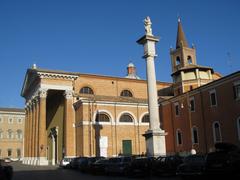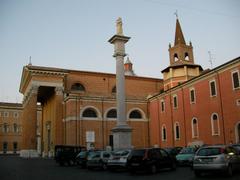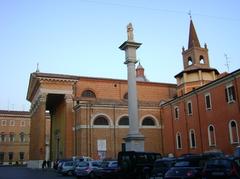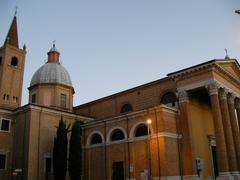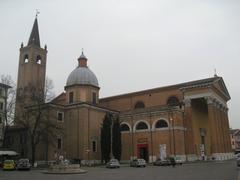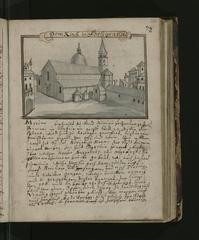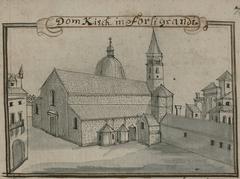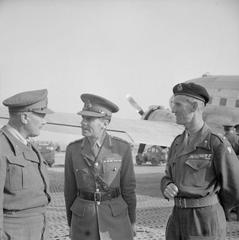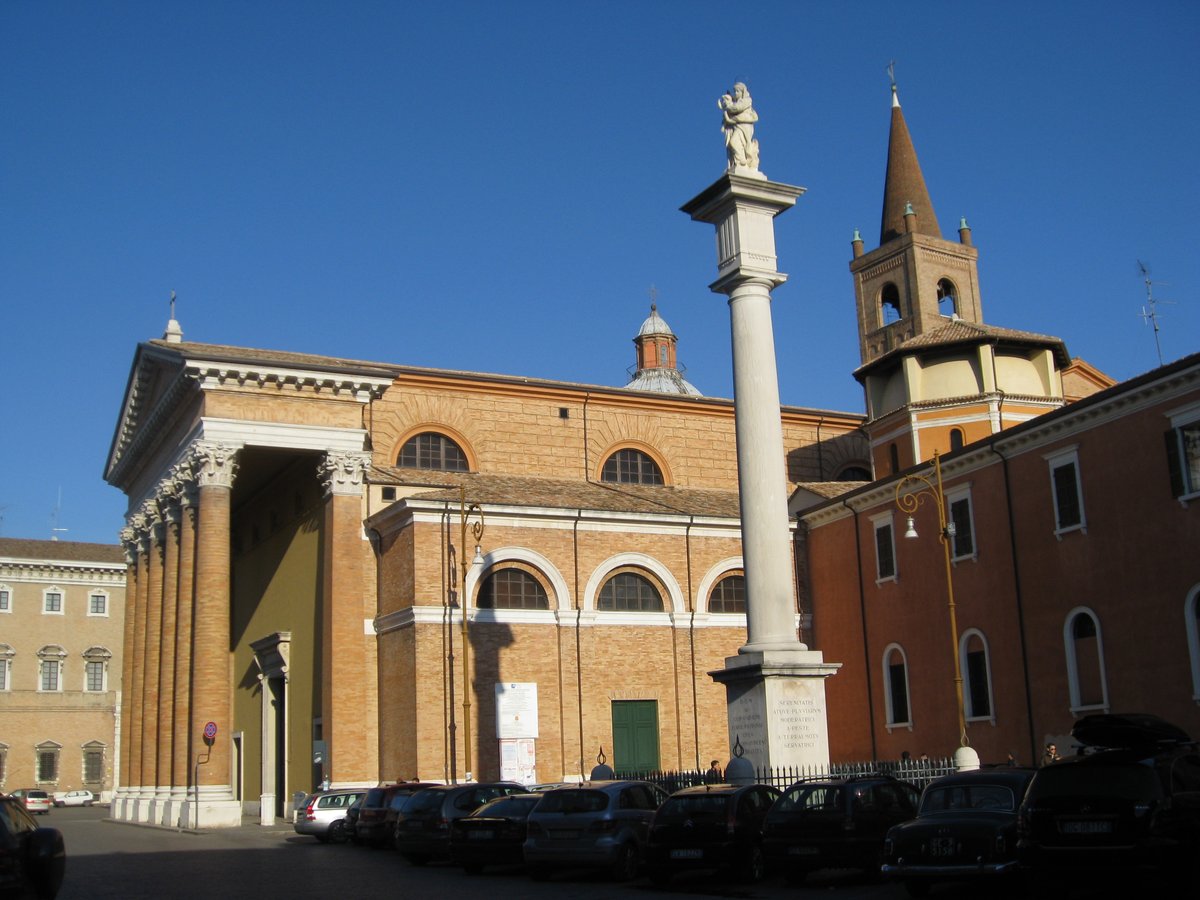
Forlì Cathedral Visiting Hours, Tickets, and Historical Sites Guide
Date: 15/06/2025
Introduction: Forlì Cathedral’s History and Cultural Significance
Situated in the vibrant heart of Forlì, Italy, Forlì Cathedral—officially the Cathedral of Santa Croce—stands as an enduring symbol of faith, artistry, and community life. As the episcopal seat of the Diocese of Forlì-Bertinoro, the cathedral encapsulates the city’s religious evolution from its 4th-century Christian roots to its 19th-century neoclassical renaissance. Visitors encounter layers of history: Romanesque solidity, Renaissance embellishments, Baroque richness, and neoclassical grandeur.
This guide offers practical information for planning your visit, including up-to-date details on visiting hours, tickets, accessibility, and guided tours. It also provides historical context and suggestions for nearby attractions, making it an invaluable resource for travelers, pilgrims, and culture enthusiasts alike.
Forlì Cathedral’s central location on Piazza Saffi places it within easy walking distance of landmarks such as the Abbey of San Mercuriale and the Musei di San Domenico, inviting visitors to immerse themselves in the city’s rich cultural landscape. Accessibility features ensure that everyone can enjoy the cathedral’s history and beauty, while guided tours and digital resources like the Audiala app enhance your understanding of this sacred site.
For the latest updates, consult the Diocese of Forlì-Bertinoro, the Forlì Tourism Board, and trusted sources such as Outdooractive, Emilia Romagna Turismo, and Travel to Italy Guide.
Table of Contents
- Introduction
- Visiting Hours and Ticket Information
- Accessibility
- Nearby Attractions and Travel Tips
- Historical Overview
- Architectural Highlights
- Religious and Cultural Significance
- Notable Events and Figures
- Forlì Cathedral in the Urban Landscape
- Frequently Asked Questions (FAQ)
- Visuals and Media Recommendations
- Conclusion
- References
Visiting Hours and Ticket Information
Opening Times:
- Monday to Saturday: 9:00 AM – 12:30 PM, 3:30 PM – 6:00 PM
- Sunday: 9:00 AM – 1:00 PM Note: Hours may vary during religious holidays and special events.
Admission:
- Free entry for all visitors. Donations are welcome to support cathedral maintenance and restoration.
Guided Tours:
Accessibility
Forlì Cathedral is committed to accessibility:
- Wheelchair ramps at the main entrance
- Accessible restrooms
- Visitors with mobility challenges are encouraged to contact the cathedral in advance for assistance
Nearby Attractions and Travel Tips
Located on Piazza Saffi, Forlì Cathedral is perfectly positioned for exploring the city’s highlights:
- Abbey of San Mercuriale: A Romanesque masterpiece just steps away
- Musei di San Domenico: Home to significant art collections
- Piazza Saffi: Surrounded by shops, cafés, and vibrant local life
Getting Around:
- Ample public transport and nearby parking
- Pedestrian-friendly city center
Travel Tip: Early morning visits offer a peaceful experience before crowds arrive.
Historical Overview
Early Origins and Foundation
Forlì Cathedral traces its origins to the early Christian era, with roots in the 4th century. Saint Mercurialis, the city’s patron and earliest known bishop, is closely associated with its foundation, reflecting Forlì’s deep spiritual heritage.
Medieval Expansion and Romanesque Influence
The cathedral grew in prominence during the Middle Ages, especially in the 9th and 10th centuries. Romanesque architecture—marked by thick walls and rounded arches—provided both spiritual gravitas and protection in turbulent times.
Renaissance Transformations
The influence of ruling families like the Ordelaffi and Riario-Sforza ushered in Renaissance ideals, bringing harmony and artistic innovation. Frescoes and illuminated manuscripts from this period connect Forlì Cathedral to broader Italian cultural movements.
Baroque Rebuilding and Neoclassical Modernization
A major transformation occurred in the 19th century: the cathedral was rebuilt in neoclassical style, preserving only the revered Chapel of the Madonna del Fuoco. The new façade, with Corinthian columns and a grand dome, symbolizes Forlì’s adaptation to modern religious and civic life.
Architectural Highlights
- Neoclassical Façade: Six Corinthian columns and a grand pediment dominate Piazza Saffi.
- Spacious Nave: Marble columns line the interior, creating light-filled symmetry.
- Chapel of the Madonna del Fuoco: The lavish Baroque chapel, spared during the 19th-century renovation, houses a miraculous image of the Madonna.
- Main Dome: Features a vibrant fresco of the Ascension of Christ.
- Artistic Elements: Marble altars, reliefs, stained glass windows, and historic sculptures enrich the visitor’s experience.
Religious and Cultural Significance
As the seat of the Bishop of Forlì-Bertinoro, the cathedral is central to the region’s religious life. Pilgrims venerate relics of Saint Mercurialis and participate in key festivals, most notably the Feast of the Madonna del Fuoco on February 4th—a vibrant event blending faith and local tradition.
Beyond religious services, the cathedral hosts concerts, exhibitions, and civic ceremonies, reinforcing its role as a cultural hub.
Notable Events and Figures
- Saint Mercurialis: Forlì’s patron, celebrated annually with pilgrimages and liturgical events.
- Madonna del Fuoco Miracle (1428): The miraculous survival of a Madonna woodcut from a fire is commemorated each February in a beloved citywide festival.
- Artistic Legacy: Contributions from renowned artists and local artisans across centuries.
Forlì Cathedral in the Urban Landscape
Forlì Cathedral’s evolution mirrors that of the city—from Roman settlement to Renaissance center and modern community. Its enduring presence on Piazza Saffi, surrounded by civic landmarks, underscores its importance as a symbol of resilience and continuity in Forlì’s urban identity.
Frequently Asked Questions (FAQ)
Q: What are the visiting hours?
A: Monday–Saturday 9:00 AM–12:30 PM & 3:30 PM–6:00 PM; Sunday 9:00 AM–1:00 PM. Hours may vary during special events.
Q: Is there an entrance fee?
A: No, entry is free. Donations are appreciated.
Q: Are guided tours available?
A: Yes, book in advance through the cathedral or local tourism offices.
Q: Is the cathedral accessible?
A: Yes, with ramps and accessible restrooms.
Q: Can I take photos inside?
A: Photography is generally allowed except during services; always be respectful.
Visuals and Media Recommendations
- Explore official photo galleries and virtual tours on the Forlì Tourism Board website.
- Use the Audiala app for audio-guided tours and interactive maps.
- Look for QR codes inside the cathedral linking to digital guides.
- Suggested photo spots: the neoclassical façade, dome, Chapel of the Madonna del Fuoco, and panoramic views of Piazza Saffi.
Conclusion
Forlì Cathedral is more than a historic monument—it is a living center of faith, culture, and community. Its architectural beauty, spiritual traditions, and vibrant festivals enrich the city’s identity and offer visitors a profound experience. Proper planning—consulting official resources, checking opening hours, and making use of guided tours—will ensure your visit is both memorable and meaningful.
For continued updates and more in-depth visitor information, reference official sites and trusted travel guides. Don’t forget to download the Audiala app for personalized tours, and follow us on social media for the latest news on Forlì Cathedral and other Emilia-Romagna highlights.
